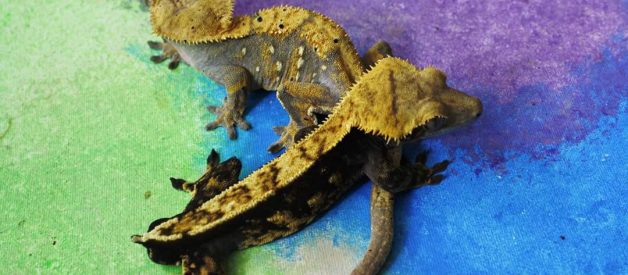So you want to breed your crested geckos but don?t know quite what you?re doing just yet. All reptile breeders have found themselves in this position at some point or another, and it?s truly an exciting place to be. There is so much to learn about breeding reptiles, but here we will specifically cover crested geckos.
I have kept many species over the years but I have always bred crested geckos as my top priority. Their ease of care and beautiful color and pattern combinations initially drew me to the idea of breeding them, but after you hatch your first egg you?ll be absolutely hooked.
I?ll break this article down into a few sections for you and you can skip around to find the information you want, or read straight through if you?re looking for some expert advice too.
Let?s start from the top.

Intro ? Should I Breed My Crested Geckos?
You may think that all you need to successfully breed crested geckos is a male gecko and a female gecko. While this is technically true, you don?t want to technically be a crested gecko breeder, you want to be a good crested gecko breeder. You want to inspire others with your productions, husbandry, and breeding ethics.
This is where expert advice comes in. If you have two brown patternless geckos and ask an experienced breeder if you should pair them, I?d say about 98% of the time they will tell you no. This is not because they think you are incapable, or that your geckos are ?ugly?. This is for the simple fact that when you produce reptiles you want to add value to the market and easily find homes for your babies. Unless you plan on keeping all of the animals you produce (which would be pretty crazy because you don?t need 8?12 new geckos every season with the same exact parents), it is wise to produce geckos that A) are geckos people want to buy and B) are, as far as you know, genetically healthy.
Also, keep in mind that the market for crested geckos right now is pretty flooded, and it might take some work to sell your geckos. Be prepared to post on for-sale websites and join Facebook groups to sell your geckos, and understand that if you don?t have anything too special, it might not sell very well.
Essentially, it?s better to breed for geckos that have a high likelihood of ending up in good homes and staying healthy, which is easiest when the gecko is an animal someone else wants to buy and has some form of traceable lineage, so you can see if the gecko?s parents were related, had health issues, etcetera.
However, if you really do plan on keeping your gaggle of geckos to yourself, this may not be an issue. Just use your best judgement when picking the geckos you want to breed. For me, it was better to wait until I got a slightly ?nicer? looking female and male pair so when I produced babies, I wouldn?t have a problem finding them homes.
When Are Geckos Ready To Breed?
A huge part of breeding crested geckos is knowing when your geckos are ready to pair up.
You want your gecko to be fully grown and large enough to safely breed, which is about 35?40 grams for males and 40+ grams for females. This size is normally reached at about 2 years of age, but can vary greatly depending on the gecko and its diet. It?s a good idea to invest in a gram scale to keep track of your geckos? weights. I tried to locate my favorite gram scale to link to here, but I?ve had it for so long that it?s gone out of style. Here is a gram scale by the same company that looks a bit nicer, but is still very cheap for the quality you get. My scale from this company is going on 6 years of use with no issues.
It?s important to remember that your female gecko is going to be carrying and producing eggs, which can be taxing and use up a lot of her resources, like fat and calcium. For this reason, it?s really key that your female is at least 40 grams before pairing her up. This way, if she starts laying and decides to be a picky eater during the process, you won?t have to panic if she starts losing a little weight. If an already-underweight female starts dropping grams while laying, she may go off food completely, which can lead to force-feeding eventually and isn?t fun for anybody involved. Also, a gecko that?s deficient in nutrients can develop Metabolic Bone Disease while laying eggs, which is a pain to treat and can be irreversible in some cases.
You don?t need to worry as much about male geckos keeping weight on during the breeding season, as they don?t normally change their behavior too much after mating and aren?t producing eggs. Your male just needs to be mature enough to produce viable sperm and large enough that if your female gets bite-y, he won?t get hurt.
 A ready-to-breed female will have a stout, but not overweight, appearance, like the female pictured.
A ready-to-breed female will have a stout, but not overweight, appearance, like the female pictured.
I?ve Got Big Geckos; What Now?
When your geckos are of proper weight, you can safely pair them up under supervision. You can put either the male into the female?s enclosure, or the female into the male?s, as long as you can see what?s going on.
Initial mating behavior commonly consists of vocalization in the form of chirps. Keep an eye on your geckos? behavior to see if one is obviously running from the other, or if either are becoming violent. If your female is ovulating (yes, geckos ovulate), she will normally accept the male?s advances. He may bite her crested or neck area before ?doing the deed?, which is fine as long as she is not fighting back. If your female seems to be terribly offended, remove the male and try again in a week or two. A female that is ovulating is much more likely to accept a male than one who is not.
If you can see that your male has successfully inserted one of his hemipenes into your female?s cloaca, it?s time to wait. Some geckos will only lock up for a few minutes, while others can take what seems like hours to finish up and go their seperate ways. Once they?re separated, you can put the geckos back in their respective enclosures. Now, we wait.
Eggs ? Don?t Panic!
Your female gecko will likely need to lay eggs within about 30 days of a successful pairing. To help along with the process, you need to have a lay box ready for her. A lay box is essentially a hide or modified plastic container with cocofiber or moss inside where your female can lay her eggs. It?s important that the lay box offers privacy as well as humidity. You don?t want your female to get cold feet about laying, and you also don?t want her eggs to dry up before you?ve had a chance to find them.
 An uncovered lay box shows this female digging before laying her eggs. This behavior can be observed so you know when to start checking the lay box for eggs, but be careful not to disturb your female too much when doing so.
An uncovered lay box shows this female digging before laying her eggs. This behavior can be observed so you know when to start checking the lay box for eggs, but be careful not to disturb your female too much when doing so.
Once your female has laid and you find the eggs, rejoice! You?re that much closer to hatching your own little sticky-footed cuties.
There are many ways to incubate crested gecko eggs, and you?ll likely find your own preference over time, but the simplest and most fool-proof method is using Repashy?s Superhatch and a deli cup. I?ve used Superhatch for years with no issues and find it to be the most reliable media for crested gecko eggs.
If you are collecting eggs from more than one gecko, I recommend using a tackle box to organize a larger amount of eggs, but a deli cup will work for one gecko?s eggs.
Line the bottom of the deli cup with about half an inch of Superhatch or an incubation media of your choice, and add enough water to dampen all of it without having standing water in the cup. Superhatch does a great job of keeping eggs from molding, but over watering eggs will promote mold growth regardless of your media.
You also have the option of buying a gecko egg organizer, which sits on top of your incubation media in your deli cup and does the moisture guesswork for you, as your eggs won?t be touching the water in the bottom of the cup so it?s less likely they will get overly wet.
 A gecko egg organizer in a deli cup with some wet superhatch underneath.
A gecko egg organizer in a deli cup with some wet superhatch underneath.
Poke a couple of very small holes in the lid of your deli cup so the eggs can get a small amount of airflow. It?s important not to over ventilate, because you don?t want your eggs to dry out. Using a safety pin and poking a few holes should do the job. If you notice your hatching media drying out within a few days, cover one of the holes up with some tape to see if that helps hold in some extra humidity.
You can place your eggs on their sides in the media, and mark the top of each egg with a marker or pencil. Once your eggs have sat for a few days, you don?t want to turn them over, which marking the top helps prevent if you need to inspect or move them.
You may also want to right the date on them so you know when they were laid and therefor know when to watch for them to hatch.
Put your deli cup in a cool place out of direct sunlight. You want your incubation temperatures to remain steady, so place your eggs somewhere where you can easily control the temperature.
The Wait ? Incubation Temps
The hardest part of breeding crested geckos is waiting for the eggs to hatch. It?s best to ?cook? your eggs low and slow, or rather, incubate them around 68?70 degrees and wait 90?120 days for them to hatch. You can incubate your geckos warmer, in the mid 70?s, and your geckos will hatch more quickly, but be warned against incubating too warm as faster growth often equates to a less robust hatchling. It?s been found by many hobbyists that geckos incubated at lower temps for longer periods of time come out bigger and with better body/crest structure, which can also translate to better health in general.
So hang in there, and remember that a watched egg never hatches. 😛
I recommend putting your eggs out of sight and checking on them every few days or so to make sure your incubation media is moist and you aren?t seeing any mold growth.
If you do see mold growing, it?s okay to take your eggs out and wipe some of the mold off with a paper towel. Just be careful not to turn your eggs over, as this could potentially kill the hatchling inside. It?s unlikely that this will happen, but it?s better to be safe than sorry.
Candling
You can check on the viability and progress of your eggs by using this tried-and-true method.
Candling is essentially the use of a bright light source to see through the semi-translucent shell of an egg. I?ve found that the LED on a smartphone is the best light to use for this, as you can turn it on, lay your phone down, and hold the egg over top of the light to see what?s inside. Again, you want to try to avoid rolling your egg over while doing this.
If your egg is fertile you should see red veins that start forming after the egg is laid. And egg that never forms veins and is only yellow inside is likely infertile, but it never hurts to wait and see if anything develops over time.
As your hatchling develops, you should start to see the egg become darker as the gecko starts taking up space inside and the light has a harder time of passing through.
Hatching(!!!)
Geckos hatch by using a tiny specialized ?horn? on their mouth area called an egg tooth, which falls off shortly after it?s used. They?ll slit an opening through their egg and slowly (or sometimes quickly) make their way out. Usually you won?t see this happen, though, and your gecko will be in your deli cup to surprise you when you look. Take a moment to freak out and take pictures of your first baby before you take him/her to its new enclosure.
 Some fresh gecko babies waiting for their new homes!
Some fresh gecko babies waiting for their new homes!
Hatchling Enclosures
Baby crested geckos are very small, weighing only about 2 grams, and need a home to fit. Any small enclosure will work for your new hatchling, but I recommend using a small rubbermaid shoebox-sized tub with vents put in the sides. This way your gecko will be able to easily locate his food, and will suffer a very low risk of hurting himself from falling. Make sure to add in some plastic plants or toilet paper rolls so your gecko can hide and feel safe. I like buying these plants from Exo Terra because you can cut them up and use them in multiple baby enclosures.
Woo! There, that should cover just about everything you need to know about breeding and hatching crested geckos. If I missed anything or you still have questions, feel free to reach out via my home blog TheReptileBlog.com!


